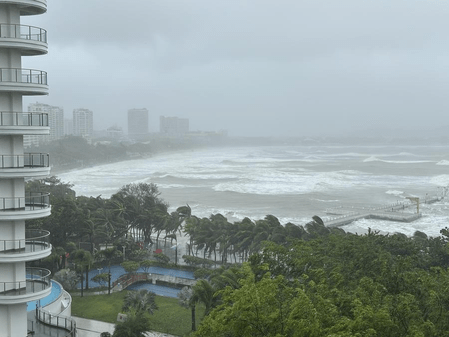Hangzhou, July 30 (IANS) Co-May, the eighth typhoon of this year, made landfall in east China’s Zhejiang Province at about 4.30 a.m. Wednesday, according to the provincial meteorological observatory.
The typhoon, with the maximum wind force near its centre reaching 23 metres per second, churned ashore at Zhoushan City of Zhejiang, Xinhua news agency reported.
Zhejiang upgraded the emergency response level for Typhoon Co-May from IV to III at 3.00 p.m. on Tuesday, according to the provincial emergency management department.
China has a four-tier emergency response system, with Level I being the most severe response.
Earlier on July 28, China’s Ministry of Water Resources had activated a Level-IV emergency flood response in four provincial-level regions — Shanghai, Jiangsu, Anhui and Jiangxi — in response to Typhoon Co-May, the eighth typhoon of the year.
Till Saturday, torrential rain is forecast in areas including Zhejiang, Shanghai, Anhui, Jiangsu and Jiangxi. Rivers and waterways around Taihu Lake may see sharp water level rises, with some small and medium rivers likely to exceed flood warning levels.
On Monday, the ministry also launched a Level-IV response in Xinjiang and the Xinjiang Production and Construction Corps due to snowmelt-driven flooding caused by persistent high temperatures. Floods along the Tarim River and its tributaries are expected to continue into mid-August.
Authorities had urged close monitoring of weather conditions, early warnings, and strengthened flood control measures to safeguard lives and property.
The typhoon is expected to move northwest at a speed of 15 to 20 km per hour, approaching the eastern part of the East China Sea and nearing the coastal areas of Zhejiang, while gradually intensifying in strength.
Typhoon Wipha, the seventh typhoon of the year, has also impacted China, particularly Hong Kong and Guangdong province, with strong winds and heavy rainfall. The typhoon caused significant disruptions to air travel, public transport, and daily life in Hong Kong, with hundreds of flights cancelled and transport services suspended. The storm also led to flooding in low-lying areas and trapped residents in some regions.
On Monday, Water conservancy authorities announced China’s No.1 flood of major rivers of 2025 in the Luanhe River, located in north China’s Haihe River Basin.
Due to recent heavy rainfall, the Luanhe River has experienced a rise in water levels. At 4.30 a.m. on Monday, the inflow rate at the Panjiakou Reservoir on the main stream of the Luanhe River rose to 2,270 cubic metres per second, according to the Haihe River Water Conservancy Commission of the Ministry of Water Resources.
–IANS
int/jk/svn
Disclaimer
The information contained in this website is for general information purposes only. The information is provided by BhaskarLive.in and while we endeavour to keep the information up to date and correct, we make no representations or warranties of any kind, express or implied, about the completeness, accuracy, reliability, suitability or availability with respect to the website or the information, products, services, or related graphics contained on the website for any purpose. Any reliance you place on such information is therefore strictly at your own risk.
In no event will we be liable for any loss or damage including without limitation, indirect or consequential loss or damage, or any loss or damage whatsoever arising from loss of data or profits arising out of, or in connection with, the use of this website.
Through this website you are able to link to other websites which are not under the control of BhaskarLive.in We have no control over the nature, content and availability of those sites. The inclusion of any links does not necessarily imply a recommendation or endorse the views expressed within them.
Every effort is made to keep the website up and running smoothly. However, BhaskarLive.in takes no responsibility for, and will not be liable for, the website being temporarily unavailable due to technical issues beyond our control.
For any legal details or query please visit original source link given with news or click on Go to Source.
Our translation service aims to offer the most accurate translation possible and we rarely experience any issues with news post. However, as the translation is carried out by third part tool there is a possibility for error to cause the occasional inaccuracy. We therefore require you to accept this disclaimer before confirming any translation news with us.
If you are not willing to accept this disclaimer then we recommend reading news post in its original language.

